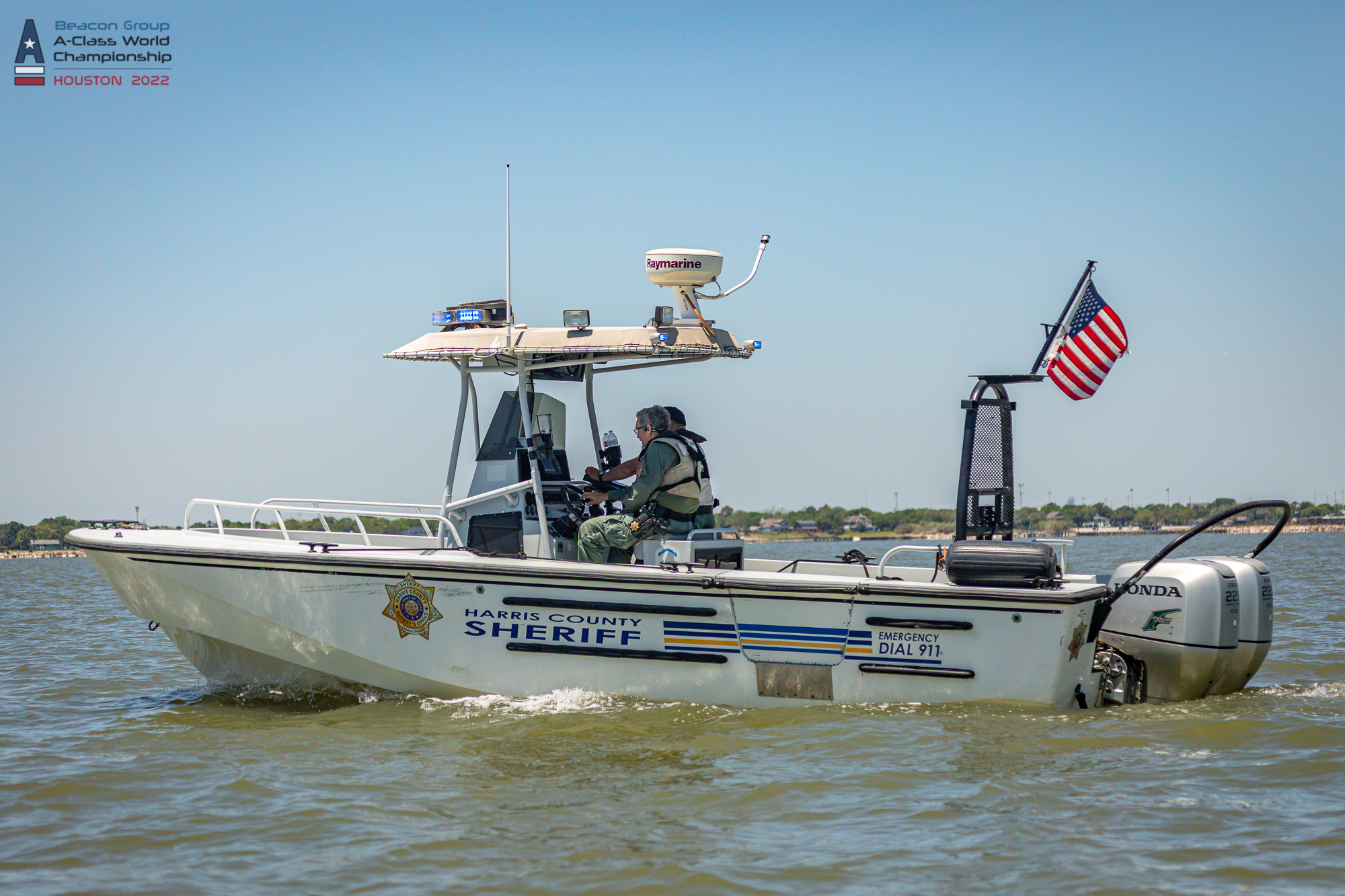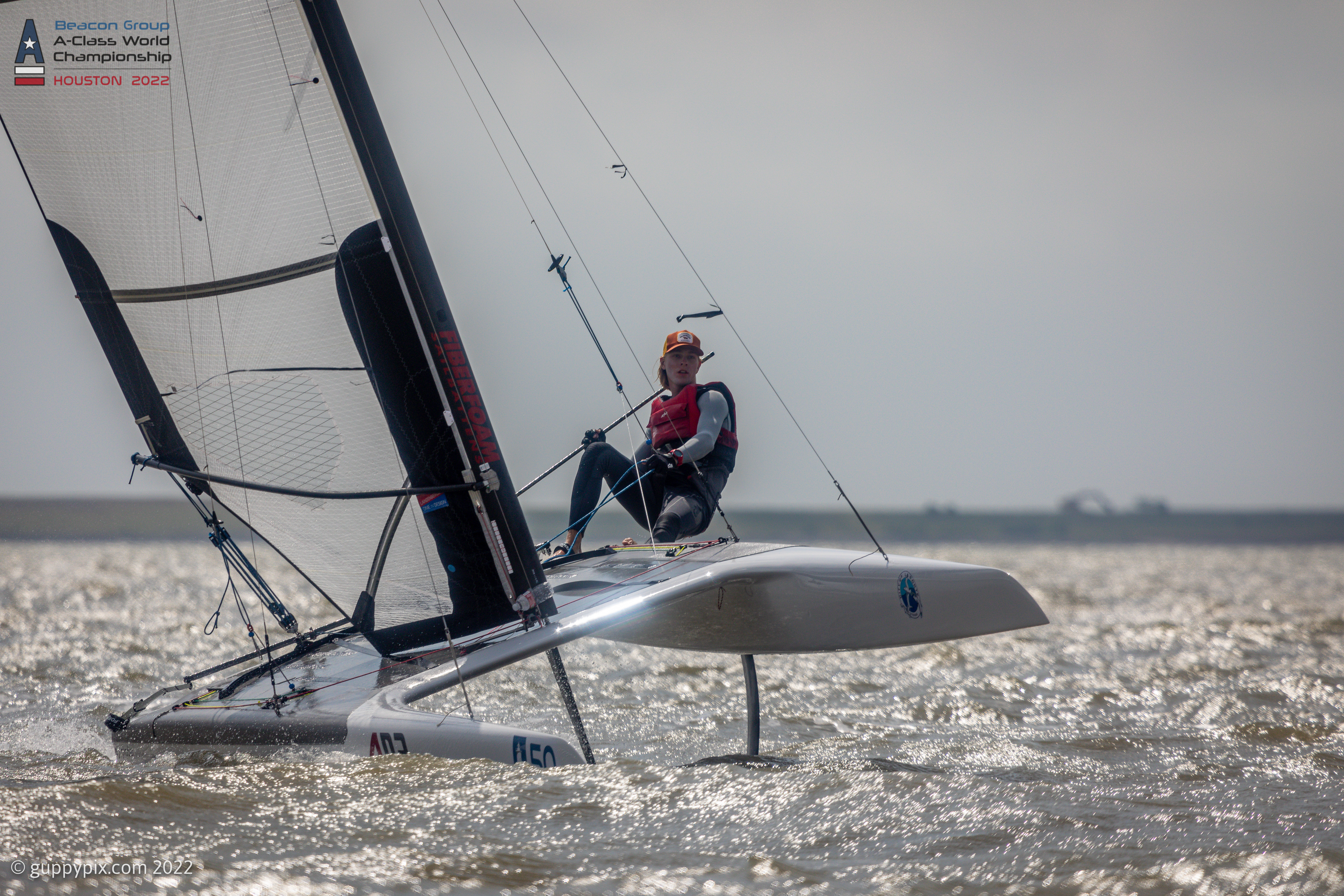The Worlds in reflection.
It has now been two weeks or so since the end of the Texas Worlds. Time to reflect on what was a really successful event. Pulled together in less than 6 months by US Class President, Bob Webbon, Bruce Mahoney and a few others, together with a hugely experience race management team under the exquisite control of Debbie Cardenas and her Houston Yacht Club team. We were lucky too to get the PRO from the last time the Worlds were in the US back in 2012, the venerable Texan, Billy Richnow, and being kept in check by his highly qualified race committee.
So, what have we learned?
‘A’ Cats are considerably faster upwind in a 3 ft chop than any chasing rib. The only thing that could keep up was the Local Harris County Sherif in his powerful twin 220hp engined patrol boat, and probably bristling with armaments. As you'll know, the 'A' Cat hull shape really works well slicing through the waves like butter. We lost 1½ days racing after the conditions, and particularly the sea state got too much. Billy canned the racing as a precaution against boats breaking. The shallow 9ft deep water, had a boat capsized and had a mast leak, it was a guaranteed mast breakage situation. Fortunately, this only happened on two occasions after boats went over and turned turtle. However, should an incident happen some way upwind of a rescue boat, in no way could that rib get to the casualty fast in those conditions. So a good call there. He managed to get some of the races back though, on the final day.
Régime change at the top of the Open Division. The old guard had to move over in the foiling class as the new young Turks forced them aside. Past masters such as Stevie Brewin, Bundy and Bruce Mahoney were, if not totally outclassed, were certainly left wanting by Ravi Parent, Kuba Surowiec and Riley Gibbs. Guys of this level of fitness and youthful talent are bound to rise to the top in the end. Although Ravi only beat Kuba on the last downwind leg of the last lap in the last race to win, so probably just came down to a single windshift or misplaced tack. That said, Bundy did show there was still life in the dog dog, with a bullet in the final race. This year the margin of places for the top 3 or 5 sailors was usually pretty close,, less that 100m in some cases, meaning that a proper fight is going on as there as much as it is lower down the fleet.
It is interesting to see the new trapeze techniques used by the top US sailors. Very Nacra 17/49er in style. Effectively getting out on the wire from a standing position rather than the swinging, kneeling or rolling out technique used by most of the fleet. This could result in snapped trapeze lines for the ‘larger gentlemen’ and the exciting possibility of the ring unhooking at the crucial moment would have similar crowd pleasing results, but it does look to work for the more lighter sailors. As suspected, the earliest on the foils will usually be the winner. In race one, Kuba was a lowly, for him, mid fleet at the first top mark, but pumped the boat onto the foils on the spreader leg and was then 500m ahead at the bottom. Upwind foiling is also the game changer again. Every race usually had the top 7-10 boats split away from the pack every time. These just happened to be the guys who can get the thing foiling uphill. Without that technique, you will be destined to become an ‘also ran’ at this level.
Many of the top racers had the latest incarnation of the Exploder Ad3. Many also kept them pretty much out of the box. OK, as few little tweaks here and there, but they became essentially the same. Most seem to have had better setting indications added. Dyneema lines with little coloured balls running along the tramp over graduated scales also coloured to indicate the mast rotation, foil rake and rudder offsets. Essential stuff, when transitioning that zone of death point at the top mark. Simply whack everything to the green lines, and you are set for downhill. At the bottom, back to the blue marks and you have uphill settings. A few others for different high or low modes and there you have it. The guesswork is all done in the pre setup and practice sailing, get that sorted and you are there, leaving you to concentrate on sailing the fast line and race tactics. Hopefully the class won’t inadvertently become a one design boat class as a result though. I’m sure sailors will keep on thinking up new shapes. Being the US, where they tend to have a more interesting culture of different boat designs and builders, and particularly home built designs, it was good to see things such as the Evo racing, with it’s very F50 looking bow and hull shapes, and predating them by several years. Odd design also arrived in the shape of Chris Bolton and his ‘Cheeseboard’ end plate design. The jury is still out on its efficacy at present though. It is deemed legal BTW, should you ask.
The Classics were very much business as usual though, this time. Landy is just too good!. Baby Landy is coming along though, so maybe one year he will do it. What we also need is for a few of the Old Guard from the foilers to transition across to the classic, realizing that the racing is closer and more competitive in this division. Someone needs to upset the cart, I’m sure Landy would relish that challenge.
We do hope that the new crop of top riders will remain in the class. It would be great to see another multiple Champion emerge, rather than them simply moving onto other boats having ticked off the box in this one. Hopefully we will see Ravi returning to defend his crown next year in Toulon, or at least mix it up with other top European sailors at Garda in September at the Euros.
And that is where the circus will head next. The fleshpots of Arco await the lucky ones who get one of the 100 allocated places for the regatta. And as said, hopefully the top riders will turn up to show it isn’t a freak result in Texas. See you all there!
Chao!







